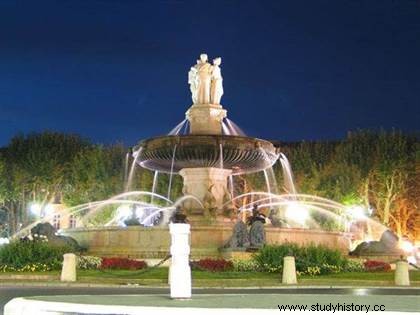 Aix-en-Provence , it is not only the student city par excellence of the 21st century where life is good. It is also a city with an undeniable historical heritage, a rich and eventful history. The first beginnings of Aquae Sextiae , the Roman town, to the city of Paul Cézanne and Émile Zola , Aix was built slowly, over the centuries … and over the water, omnipresent in the city of Roy René . In Aix , everything is history. Halfway between France and Italy, this is a unique city that every history lover must visit, and that he certainly cannot forget. On this subject, Cézanne said:"When you're born there, it's screwed up, nothing tells you more ”.
Aix-en-Provence , it is not only the student city par excellence of the 21st century where life is good. It is also a city with an undeniable historical heritage, a rich and eventful history. The first beginnings of Aquae Sextiae , the Roman town, to the city of Paul Cézanne and Émile Zola , Aix was built slowly, over the centuries … and over the water, omnipresent in the city of Roy René . In Aix , everything is history. Halfway between France and Italy, this is a unique city that every history lover must visit, and that he certainly cannot forget. On this subject, Cézanne said:"When you're born there, it's screwed up, nothing tells you more ”.
Aquae Sextiae:the Roman city
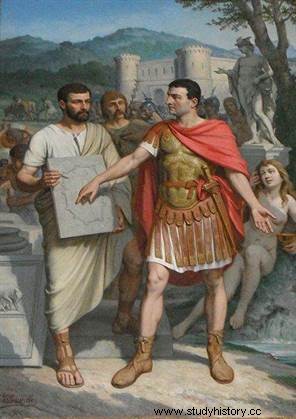 The history of Aix begins in 124 Before our era. Gaius Sextius Calvinus , Roman consul, decides to destroy the oppidum of Entremont , local gathering center of the Salyenne Gallic tribes. The Oppidum of Entremont is still visible today, and is located north of the current city of Aix-en-Provence . Two years later, in 122 BC. AD ., Gaius Sextius Calvinus founded the city of "Aquae Sextiae at the foot of Entremont . The Roman consul chose this site for a pragmatic and strategic reason:the location of Aquae Sextiae is on the road between Italy and the Iberian Peninsula, and between the Mediterranean Sea and the natural border that is the Durance. This is what motivated the consul Quintus Marcius Rex , four years later, in 118 BC. AD , in the founding of the city of Colonia Narbo Martius , today called Narbonne .
The history of Aix begins in 124 Before our era. Gaius Sextius Calvinus , Roman consul, decides to destroy the oppidum of Entremont , local gathering center of the Salyenne Gallic tribes. The Oppidum of Entremont is still visible today, and is located north of the current city of Aix-en-Provence . Two years later, in 122 BC. AD ., Gaius Sextius Calvinus founded the city of "Aquae Sextiae at the foot of Entremont . The Roman consul chose this site for a pragmatic and strategic reason:the location of Aquae Sextiae is on the road between Italy and the Iberian Peninsula, and between the Mediterranean Sea and the natural border that is the Durance. This is what motivated the consul Quintus Marcius Rex , four years later, in 118 BC. AD , in the founding of the city of Colonia Narbo Martius , today called Narbonne .
Originally, Aquae Sextiae had an architecture similar to that which was then present at Entremont . Nevertheless, “Gallic town planning” was gradually abandoned, in favor of a more Roman architectural practice. At I st century BC. J.-C., when the Roman settlement on the site proved to be definitive, the city adopted an orthogonal urban plan, according to the characteristics of the "Hippodamian plan":a cardo and a decumanus , and a forum is erected. Specifically, archaeologists unearthed three megrims , i.e. three north-south urban axes, three streets. The originality of the city of Aquae Sextiae , at I st century BC. J.-C., lies in its Gallo-Roman construction:if the town planning is quite characteristic of Roman cities, the interiors of the habitats are very summary, revealing the Gallic populations of Salyenne.
In the sources, the evocation of the foundation of Aix , or rather Aquae Sextiae , is still present, despite the gaps relating to the posterity of the events described. Livy , Roman "historian" of the I st century BC, and Strabo , geographer of the same period, were the first to mention in the sources the foundation of the city. In this regard, Strabo calls it "polite “, in the Greek sense of the term, that is to say of a “city”. Livy , meanwhile, in its Epitome , talks about Aquae Sextiae as a "colony “, installed in this place because of the presence of “hot and cold springs », which gave their name to the city.
Indeed, in Latin, “Aquae Sextiae means "Sextian Waters from the name of the founding consul. Several hundred years later, in the sixth century AD, the chronicler Cassiodorus says, in this regard, that was founded "in the Gauls a city where the Sextian waters are ". From the beginning, Aquae Sextiae must take on a surveillance role in the region. The Salyens are renowned for being inexhaustible warriors. In this sense, the newly established city, which also saw a Roman garrison quickly settle within it, must protect Marseille and the road that leads to Rome. Aquae Sextiae also served as the basis for the conquest of Gaul Narbonnaise, which took place four years later, and which saw the foundation of Narbonne , then called Colonia Narbo Martius , as we mentioned earlier. Archaeological excavations are regularly carried out in Aix-en-Provence , and it is not uncommon to find traces of Roman “Aixois” ancestors.
Nevertheless, the most significant event related to the city of Aix was the Battle of Aquae Sextiae , which took place in 102 before our era, and which brought to grips the Roman troops of the consul Caius Marius to hordes of Cimbri and Teutons, coming from Northern Europe. However, the battle did not take place in the city, but not far from there, about ten kilometers to the east, on the southern piedmont of the Sainte-Victoire mountain, which already took on a whole new dimension. historical. Plutarch , author of Parallel Lives , gave an account of the battle, when he wrote his Vie de Marius . This is a turning point for the city, which is developing more and more at this time. It acquires an enclosure, strengthens itself.
In 2004 , archaeological excavations have also revealed the presence of a theater, which makes it possible to affirm that the city was then experiencing a certain demographic development. Likewise, it is now clearly established that the city of Aquae Sextiae , oriented from the beginning towards thermal and aquatic activity, due to the presence of numerous water sources, had thermal baths. Three aqueducts, all built by the Romans, supplied the city with water. The Roman authorities then multiplied the communication channels inside the enclosure and improved them. As we can see opposite, the cardo was found by archaeologists, and passed north of the current city, under the Saint-Sauveur Cathedral. This is how Aquae Sextiae became, from the principate of Augustus , a Roman city in its own right, fully integrated into the Empire.
 Nevertheless, in the 3rd century, Aquae Sextiae is gradually bogged down in a demographic decline, which seems to become more and more inevitable as time goes by. Dwellings, domus , are gradually neglected, abandoned. In 1842 , archaeological excavations were carried out, and the researchers were able to observe the extent of the “damage”:richly decorated houses, but for the most part left in a state of abandonment, sewer network that had become inoperative, destruction, etc. Nevertheless, it is necessary to qualify this not very idyllic picture corresponding to a neglect of the city of Aquae Sextiae .
Nevertheless, in the 3rd century, Aquae Sextiae is gradually bogged down in a demographic decline, which seems to become more and more inevitable as time goes by. Dwellings, domus , are gradually neglected, abandoned. In 1842 , archaeological excavations were carried out, and the researchers were able to observe the extent of the “damage”:richly decorated houses, but for the most part left in a state of abandonment, sewer network that had become inoperative, destruction, etc. Nevertheless, it is necessary to qualify this not very idyllic picture corresponding to a neglect of the city of Aquae Sextiae .
The city remained, however, at that time, the capital of the Second Narbonne, and was de facto "superior" politically to Antipolis (Antibes ) or Forum Julii (Fréjus ). The major turning point took place around the turn of the 5th and 6th centuries, in a general context of the expansion of Christianity in the West. Aquae Sextiae was no stranger to the phenomenon:the Roman forum was destroyed, and replaced by a small episcopal group, composed in particular of a baptistery that can still be seen today (it is in the Saint-Sauveur cathedral). The city gradually took on the name of "Aix in the sources. at the very moment when it was erected into a bishopric. From then on, the city of Aix became an essential political place, central in the region.
Aix-en-Provence, capital of Provence
Aix also suffered the "barbarian invasions". In 477 , it was invaded by the Visigoths, then by the Ostrogoths in 508 . In the 6th century, the Franks and the Lombards took the city. Finally, we can attest to the presence of the Saracens in the 8th century. From then on, the political role of the city decreased:after the invasion of the Franks in 536 , it was stripped of the status of capital of the Second Narbonnaise which was its own, in favor of Arles . It was not until the 8th century and the Carolingians that the city of Aix regains its former glory. The city therefore entered a phase of demographic redevelopment, and grew little by little. Three distinct towns are then identifiable – the city of Tours, the county town, and Saint-Sauveur – and each has fortified walls. Nevertheless, Aix had to wait until the twelfth century to fully recover its past luster, and more precisely the year 1189 , which saw the installation of the counts of Provence in the city. Aix then took his revenge on Arles , and distinguished itself from Avignon . This is the beginning of the "beautiful story" of Aix , which became for six centuries the capital of Provence, the county and the province.
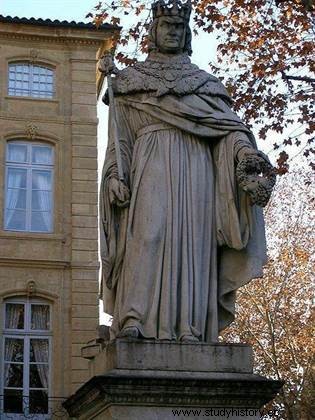 In the 15th century, René I
st
from Anjou gave a major impetus to the city of Aix . The "good King René", who was also Count of Guise, Duke of Bar, Duke of Lorraine, Duke of Anjou, Count of Provence and Forcalquier, King of Naples, King of Jerusalem, and King of Aragon - excuse me for little ! – was a fine manager, and made all the cities where he stayed prosper, Angers and Aix on your mind. In a Renaissance and Italianate context, King René maintained a scholarly court in Aix . His father, Louis II of Anjou , had also created in 1409 a university in the city (this is the current Institute of Political Studies, located opposite Saint-Sauveur Cathedral), which celebrated its 600th anniversary with great fanfare in 2009 . The sovereign is still considered, even today, as the "protector" of the city, as the most emblematic character in its history.
In the 15th century, René I
st
from Anjou gave a major impetus to the city of Aix . The "good King René", who was also Count of Guise, Duke of Bar, Duke of Lorraine, Duke of Anjou, Count of Provence and Forcalquier, King of Naples, King of Jerusalem, and King of Aragon - excuse me for little ! – was a fine manager, and made all the cities where he stayed prosper, Angers and Aix on your mind. In a Renaissance and Italianate context, King René maintained a scholarly court in Aix . His father, Louis II of Anjou , had also created in 1409 a university in the city (this is the current Institute of Political Studies, located opposite Saint-Sauveur Cathedral), which celebrated its 600th anniversary with great fanfare in 2009 . The sovereign is still considered, even today, as the "protector" of the city, as the most emblematic character in its history.
In this regard, one of the main arteries of the city bears his name – the “Boulevard du Roy René –, and his statue is placed at the very top of the Cours Mirabeau, the emblematic avenue of the city. Moreover, in the 21st century, it is not uncommon to speak of the "Cité du Roy René" in connection with Aix-en-Provence . Rene I er settled in 1476 in Aix , where he died. A man of culture, he wrote many poetic works, inspired by the genre of the courtly novel. He was also, in accordance with Renaissance tradition, a patron:he was, in this respect, the protector of the painter Nicolas Froment , who also produced the famous triptych of the Burning Bush , where he staged King René and Queen Jeanne . In a way, King René is the Aix incarnation of the Renaissance, of this transition which then took place between the Late Middle Ages and the modern era.
In 1486 , Provence lost its independence. The county of Provence and Forcalquier then became a province attached to the Kingdom of France, placed under the supervision of a governor. Fifteen years later, in 1501 , King Louis XII of France created the Parliament of Provence, which was installed in the city of Roy René (today, the Parliament room is still visible, and is located at the Town Hall). Aix , despite the change of sovereignty that took place at the end of the 15th century, therefore retained a preeminent role at that time. It passes from the status of capital of the county of Provence to that of capital of the province of Provence. Nevertheless, the subjection to the French monarchy was badly experienced and perceived by the local elites. The religious wars in the 16th century did nothing to help the situation.
Indeed, when King Charles IX of France organizes his “royal tour” and joins the city of Aix, the city is in the grip of troubles, in revolt against the governor of Provence, considered to be too close to the Huguenots. Similarly, Louis XIII visit Aix in 1622 . The city, deeply Catholic, welcomed the sovereign with undisguised enthusiasm. The originality of the city of Aix , between the 16th and 17th centuries, lies in the ambiguity it adopts and maintains with regard to royalty:opposed to royal power, it nevertheless celebrates it when it fights the Protestants. The Slingshot (1648 -1653 ) has also been very significant in the region. Once in power, King Louis XIV , on the way to Marseille , whom he punished for his participation in rebellious events, stopped at Aix , where he stayed for some time at the private mansion of Châteaurenard, in the old center of the city.
At that time, Aix is no longer considered a seditious city, as "Provençal". It loses its identity in favor of the celebration of the court splendor of Louis XIV . Aix rallies, under the reign of the "Sun King", the French domination. It was also at this time, in the 17th century, that the last major urban expansion of the city took place, under the leadership of Cardinal Michel Mazarin , brother of Jules Mazarin . With the authorization of Louis XIV , Mazarin demolished the southern rampart of the city of Aix , and created a new district, which will later bear his name, and which still exists today. The local elites settled there little by little, and, not wanting to have to "submit" the vision of the more humble residences of the old center of the city, asked the architect Jean Lombard to create a long promenade. This is the artery that became in 1876 the “Cours Mirabeau”, the showcase of the city of Aix, as well as its new entrance door – to which was added the “Rotonde”, a majestic fountain.
Aix also experienced the troubles of the French Revolution. At the forefront of protest, the city of Roy René quickly became passionate about revolutionary and anti-revolutionary struggles. Finally, in 1790 , the Departmental Assembly of the department of Bouches-du-Rhône is created, and replaces the former Parliament of Provence, which is dissolved. In short, despite the troubles that hit France, Aix retained a prominent role. In a way, since Antiquity, the city seems to have been invested with the “protection” of History. Nevertheless, despite the revolutionary fury that descended on the city, Aix is gradually entering a political decline. The city, so flourishing in modern times, is increasingly discredited by administrators. And even if Jean-Marie-Étienne Portalis , Varois who studied in Aix and editor of the Civil Code , helped restore the image of the city, it is not so. It was not until the second half of the 19th century that the city of Aix emerged from its lethargy.
In the footsteps of Cézanne … to Vasarely (19th - 20th centuries)
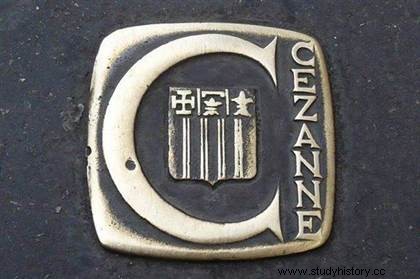 City of water since antiquity, Aix became, in the 19th century, a “city of art”. Cézanne still haunts the alleys of the city of King René . The proof is that, nowadays, we can follow the painter's journey through the city, bronze plaques being fixed to the ground, in the streets, allowing visitors to reach the places he frequented (see opposite). Thus, in the second half of the 19th century, Aix proves to be the breeding ground for talented artists and illustrious men:Paul Cézanne , Émile Zola , Adolphe Thiers , Joseph d'Arbaud , François-Marius Granet or even Darius Milhaud constitute a thin fringe of the local pantheon. At the same time as it is experiencing a resurgence of intellectual interest, the city seems to be opening up to the world, and abandoning the ambient conservatism that has characterized it since the fall of the monarchy at the end of the 18th century.
City of water since antiquity, Aix became, in the 19th century, a “city of art”. Cézanne still haunts the alleys of the city of King René . The proof is that, nowadays, we can follow the painter's journey through the city, bronze plaques being fixed to the ground, in the streets, allowing visitors to reach the places he frequented (see opposite). Thus, in the second half of the 19th century, Aix proves to be the breeding ground for talented artists and illustrious men:Paul Cézanne , Émile Zola , Adolphe Thiers , Joseph d'Arbaud , François-Marius Granet or even Darius Milhaud constitute a thin fringe of the local pantheon. At the same time as it is experiencing a resurgence of intellectual interest, the city seems to be opening up to the world, and abandoning the ambient conservatism that has characterized it since the fall of the monarchy at the end of the 18th century.
It is in this particular context that the municipality Aude , in 1848 , decided to destroy the medieval and modern ramparts of the city of Aix. The gates and the ramparts were then destroyed, to such an extent that today, nothing or almost nothing bears direct witness to their past existence in the city. The only visible part of the historic enclosure is to the north of the old center, on the site of the current "peripheral boulevard":it is a single and unique tower, which has survived, posing as a real challenge to the throes of time and history. The destruction lasted nearly a quarter of a century, ending in 1874 . Nevertheless, at that time, Aix remained a very compartmentalized city, isolated from the rest of the region and from the means of communication. It was not until 1870 for the city to have a railway, while the PLM (Paris-Lyon-Marseille) rallied Paris in Marseille since the 1840s. Seven years later, in 1877 , the city was – finally – connected to Marseille . From then on, the delay accumulated by the city was filled little by little, and Aix received a resurgence. The arrival of the train allowed travelers from all walks of life to take an interest in the charms of the region, and in particular the Sainte-Victoire, endlessly painted by Paul Cézanne . The city prospered, and suffered only relatively the troubles of the two world wars.
Aix-en-Provence, a dynamic city
The 1970s, however, marked a real turning point for Aix , which opens outward. New higher education establishments are set up, including three universities (University of Provence Aix-Marseille I; University of the Mediterranean Aix-Marseille II; University Paul Cézanne Aix-Marseille III). Under the Ciccolini municipality , large housing complexes were erected, and the population of Aix rose from 54,000 inhabitants in 1954 at 137 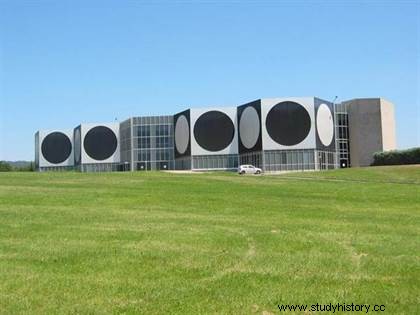 000 in 198 2 . Aix also benefited, at this time, from the installation of advanced industries, in particular at the Etang de Berre, and from the Cadarache nuclear study center. At the same time, the city of Aix became a tourist hotspot:in 1948 the Festival d’Art Lyrique is created, which is now internationally renowned.
000 in 198 2 . Aix also benefited, at this time, from the installation of advanced industries, in particular at the Etang de Berre, and from the Cadarache nuclear study center. At the same time, the city of Aix became a tourist hotspot:in 1948 the Festival d’Art Lyrique is created, which is now internationally renowned.
The city is expanding considerably, and is proving to be one of the most dynamic in France. A city of economy, it also became a large-scale university center and a cultural capital for the whole region, since it acquired seven museums... and the Vasarely foundation, named after the famous Hungarian painter, located in the new Jas-de-Bouffan district in 1974 . Vasarely has chosen the location of its “museum” in Aix because of its dynamism, as he has also expressed:"The choice of Aix-en-Provence - apart from the gesture of the municipality and the dedication of the personalities of the city was dictated by the rich past of Aix-en-Provence, its artistic and architectural activities, its famous festival, its exceptional motorway network, finally, my admiration for Cézanne:indeed, the Foundation is located at a place called “Jas de Bouffan”, where the brilliant initiator of the plastic arts of the present lived. »
In short, in the 20th century, Aix has been able to take on board its cultural, political heritage – the Court of Appeal is still located there –, but also economic. In this, and for all these reasons, this is a city that we invite you to discover. In recent years, in addition to municipal political unrest – the municipal elections of 2008 were canceled by the Council of State – the city maintains “its” heritage. Having become a major university city – almost a third of the Aix population is a student –, Aix is a very dynamic commune, which arouses both the interests of its large neighbor Marseille , and sometimes even his jealousy …
Bibliography
- LE CHRISTMAS Marie-Nicole, Aix-en-Provence:discovering a city and its history , Aix-en-Provence, Edisud, Coll. Travel diaries, 2009.
- BOUYALA D’ARNAUD André, Evocation of old Aix-en-Provence , Paris, Editions de Minuit, Coll. Old Paris, 1964.
